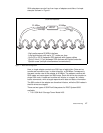14 IBM Certification Study Guide AIX HACMP
• SP Switch is a high-speed packet switching network, running on the
RS/6000 SP system only. It runs bidirectionally up to 80 MBps, which adds
up to 160 MBps of capacity per adapter. This is node-to-node
communication and can be done in parallel between every pair of nodes
inside an SP. The SP Switch network has to be defined as a private
Network, and ARP must be enabled. This network is restricted to one
adapter per node, thus, it has to be considered as a Single Point Of
Failure. Therefore, it is strongly recommended to use AIX Error
Notification to propagate a switch failure into a node failure when
appropriate. As there is only one adapter per node, HACMP uses the
ifconfig alias addresses for IPAT on the switch; so, a standby address is
not necessary and, therefore, not used on the switch network. Hardware
address swapping also is not supported on the SP Switch.
For IP Address Takeover (IPAT), in general, there are two adapters per
cluster node and network recommended in order to eliminate single points of
failure. The only exception to this rule is the SP Switch because of hardware
limitations.
2.2.2 Non-TCPIP Networks
Non-TCP/IP networks in HACMP are used as an independent path for
exchanging messages or heartbeats between cluster nodes. In case of an IP
subsystem failure, HACMP can still differentiate between a network failure
and a node failure when an independent path is available and functional.
Below is a short description of the three currently available non-TCP/IP
network types and their characteristics. Even though HACMP works without
one, it is strongly recommended that you use at least one non-TCP/IP
connection between the cluster nodes.
2.2.2.1 Supported Non-TCP/IP Network Types
Currently HACMP supports the following types of networks for non-TCP/IP
heartbeat exchange between cluster nodes:
• Serial (RS232)
• Target-mode SCSI
• Target-mode SSA
All of them must be configured as Network Type: serial in the HACMP
definitions.


















